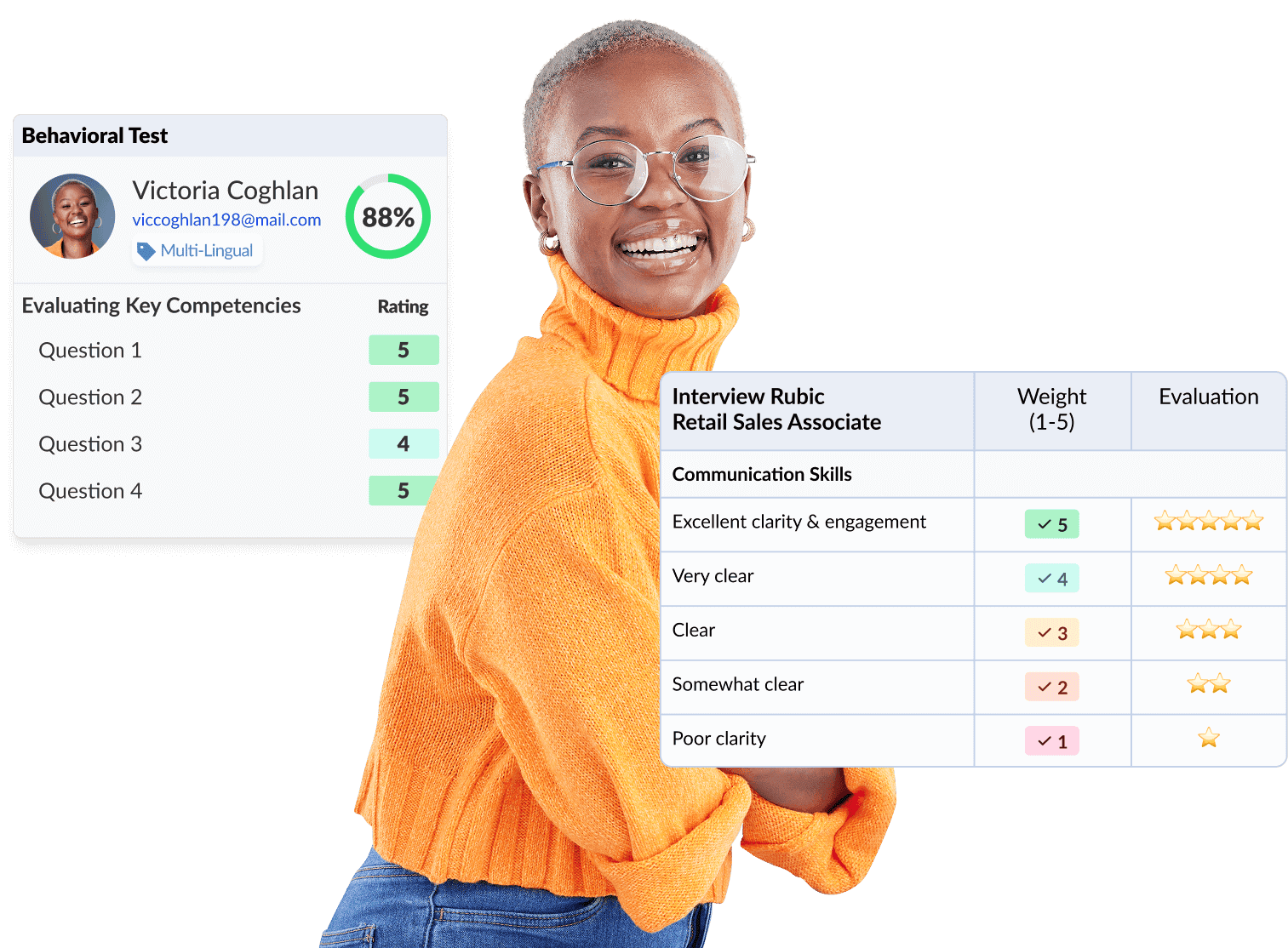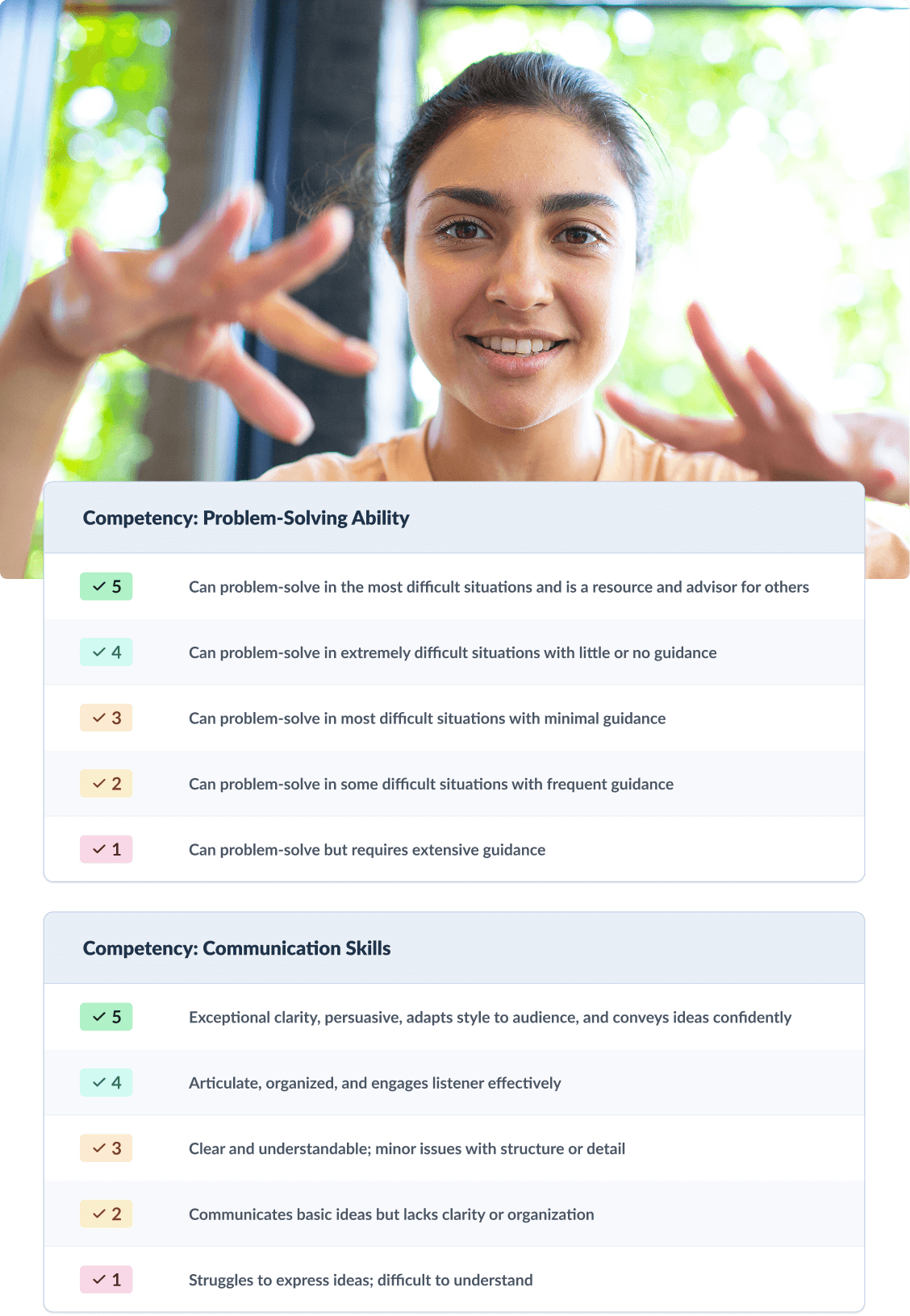
How To Conduct a Structured Interview
Learn how to conduct structured interviews effectively with our comprehensive guide.
Written by
VidCruiter Editorial TeamReviewed by
VidCruiter Editorial TeamLast Modified
Nov 5, 2025
TL;DR: Why Companies Need An Interview Rubric
If you’ve ever left an interview debrief wondering why one interviewer loved a candidate and another wasn’t convinced, you’ve seen what happens when structure is missing. An interview rubric brings clarity to the process by setting a shared standard for evaluation.
Here’s why companies that use them make better hiring decisions:
Every hiring manager wants to make fair, consistent decisions, but unstructured interviews often make that impossible. When each interviewer asks different questions or uses their own mental scale to rate answers, bias creeps in, and qualified candidates can be overlooked.
A well-designed interview rubric provides your team with a shared framework for evaluating candidates based on the same criteria and standard every time. Your small but mighty team can transition from gut-feel assessments to evidence-based hiring decisions that make hires easier to justify and more defensible if challenged.
In this guide, we’ll break down exactly how to create a fair interview rubric, from defining your criteria to training evaluators and avoiding common pitfalls. You’ll see how structured interview tools can help teams apply rubrics consistently across interviews, roles, and departments, ensuring every candidate gets an equal opportunity to shine.

An interview rubric is a structured scoring guide that helps hiring teams evaluate candidates using the same criteria and rating scale. Instead of relying on gut instinct or loosely defined impressions, a rubric outlines exactly what “excellent,” “average,” or “needs improvement” looks like for each skill or competency being assessed.
Rubrics are a roadmap for fair interviews. Each interviewer uses the rubric to rate responses consistently, whether they’re evaluating communication skills, leadership potential, or technical ability. These tools not only make scoring more objective but also help teams compare candidates on equal footing.
A strong interview rubric usually includes:
When done well, rubrics make interviews more structured, transparent, and repeatable, which lays the foundation for confident, defensible hiring decisions.

Fair interview rubrics are a foundation for better hiring decisions. When every candidate is evaluated using the same framework, you protect both the candidate experience and your organization’s credibility.
Bias Reduction and Legal Defensibility
Unstructured interviews often leave room for hiring bias, even when interviewers have the best intentions. A fair rubric helps eliminate subjective decision-making by clearly defining what success looks like for each competency. This documentation also serves as a safeguard if hiring decisions are ever questioned, providing evidence that evaluations were based on objective, job-related criteria.
Consistency Across Multiple Interviewers
When several interviewers meet the same candidate, their impressions can vary widely. A shared rubric creates alignment by ensuring everyone evaluates the same criteria in the same way. This consistency improves reliability whether a candidate meets with one interviewer or several.
It also streamlines debriefs, turning subjective opinions into comparable data points that are easier to discuss and agree on.
Improves Candidate Experience and Employer Brand
Candidates notice when an interview process feels fair and organized. Using a rubric helps create that impression by ensuring everyone is asked similar questions and evaluated on the same standards. That sense of fairness builds trust and strengthens your employer brand, even among those who are not selected.
Google has also seen the benefits of this approach. In its re:Work guide on structured interviewing, Google reports that standardized interviews supported by rubrics improve predictive validity, reduce bias, and make the hiring experience more positive for candidates. Fair rubrics lead to better data and more confident hiring decisions.
A fair interview rubric is carefully designed to keep evaluations objective, measurable, and consistent across every interviewer and candidate. These are the core components that make an interview rubric an effective tool for HR teams.
Each rubric should start with clear, job-related criteria or the skills and competencies directly tied to success in the role or company. Defining these skills keeps interviewers focused on what matters most rather than personal preferences or surface-level impressions.
For example, instead of vague traits like “team player,” define measurable criteria such as collaboration, problem-solving, or communication under pressure. The clearer your criteria, the easier it is for every interviewer to stay aligned.
Behavior-based scoring connects evaluation directly to what candidates say and do during the interview. Instead of rating someone on perceived potential, interviewers assess observable evidence, such as specific examples, stories, or behaviors, that demonstrate the desired skill.
This approach reduces guesswork and makes it easier to justify scores. For instance, a “5” in communication might mean the candidate “clearly structures complex ideas and adapts tone to audience,” while a “2” might mean “struggles to organize thoughts or provide examples.”
Even the best rubric only works if interviewers interpret it the same way. Calibration sessions, where hiring teams review sample answers and discuss scoring, help align expectations and reduce variability.
Regular calibration keeps scoring consistent over time, especially when new interviewers join or when roles evolve. These sessions also provide a valuable opportunity to refine rubric criteria based on real-world use.
Every score and note should be documented in a centralized system for transparency and compliance. Proper documentation creates an audit trail showing that each hiring decision is based on structured, job-related evidence.
This recordkeeping is increasingly important in light of rising legal scrutiny around hiring bias, particularly in cases involving automated or AI-assisted systems. As noted in a Clark Hill analysis, courts are beginning to hold organizations and technology providers accountable when hiring tools produce biased or unvalidated outcomes.
Even if your process is entirely human-led, thorough documentation makes it easier to demonstrate fairness if hiring decisions are questioned. In the event of a lawsuit or mediation, having detailed records allows HR and legal teams to review interview evidence quickly and respond confidently to allegations.

Building a fair interview rubric takes thoughtful planning and collaboration. The goal is to create a tool that reflects your organization’s values, supports structured evaluation, and helps every interviewer make confident, consistent decisions.
Define Job-Specific Competencies
Start by identifying the skills, traits, and competencies that directly impact success in the role. Use job descriptions, performance data, and input from current high performers to determine what truly matters.
For example, a customer service role might emphasize communication, empathy, and problem-solving, while a technical role may prioritize analytical thinking and collaboration. Keep the list focused, as too many criteria can dilute scoring clarity.
Write Clear Rating Scales
Once competencies are defined, create a scale that describes what each performance level looks like. Aim for specific, behavior-based language rather than generic terms like “excellent” or “poor.”
A 1–5 scale is common, where “1” represents minimal demonstration of a skill and “5” reflects mastery. Defining what each level means ensures that interviewers interpret scores consistently, even if they use personal phrasing in notes.
While a 1–5 scale provides structure, not every role requires a candidate who scores a five across the board. In many organizations (especially startups or growing teams), a mix of scores can be ideal.
For instance, a marketing candidate might score a three in paid advertising but a five in communication and collaboration. That combination could indicate strong growth potential: someone who can quickly learn technical tasks while already excelling in interpersonal or leadership skills that strengthen team dynamics.
The key is to define what balance works for your organization. Some competencies can be developed with time and training, while others are harder to teach. HR and hiring managers may weigh these priorities differently depending on team structure, budget, and long-term goals. A fair rubric should recognize both current capability and future potential, not just perfection in every category.
Train Interviewers on Consistent Scoring
Training is the bridge between a good rubric and a fair interview process.
This step helps reduce personal bias and ensures every interviewer understands the intent behind each competency and rating. Consider refresh sessions periodically, especially when adding new team members or updating roles.
Pilot and Refine Your Rubric
Before rolling out the rubric company-wide, test it with a small group of interviews. Look for feedback on usability, clarity, and scoring variation. Were some competencies hard to evaluate? Did interviewers interpret scales differently?
Use that feedback to fine-tune wording, criteria, or the number of rating levels. A rubric should evolve alongside your hiring needs, so treat this as a living document.
Once you’ve defined your competencies and rating scales, the next step is putting everything into a usable format. A well-structured interview rubric enables hiring teams to record evaluations, compare candidates, and stay aligned on what good performance looks like.
Below we’ve compiled an example layout you can adapt to your organization’s needs. Whether you’re creating a simple spreadsheet or using structured interview software, the goal is the same: give interviewers a clear, consistent way to score every candidate based on the same criteria.
Score
Values Alignment
Adaptability
Work Ethic & Initiative
Clearly demonstrates values that align with company mission; examples provided
Embraces change; flexible and proactive
Self-motivated; goes above and beyond
Values mostly align; some examples
Adapts well; occasional hesitation
Motivated; completes tasks reliably
Some alignment; limited examples
Adapts with some guidance
Meets expectations; limited extra effort
Little alignment; vague examples
Resistant to change; slow to adapt
Minimal initiative; needs supervision
Values conflict with company culture
Unable or unwilling to adapt
Lacks motivation; avoids responsibility
Even the most well-intentioned teams can miss the mark when creating interview rubrics. Oversights, like unclear wording or too many evaluation points, can quickly undo the fairness and consistency you’re trying to build. Watch out for these common mistakes as you develop your rubric.
A long list of competencies might feel thorough, but it often leads to confusion and scoring fatigue. When interviewers are juggling ten or more criteria, they’re more likely to rely on gut instinct instead of careful evaluation.
Keep your rubric focused on the few competencies that truly define success for the role—typically five to seven at most. This balance makes scoring more consistent and meaningful.
Daniel Kahneman, author of Thinking, Fast and Slow, has suggested that interviewers should focus on about six key dimensions when evaluating candidates. His work on decision-making shows that too many data points can overwhelm judgment, leading evaluators to default to intuition instead of objective reasoning.
Phrases like “strong communicator” or “shows leadership” don’t mean the same thing to every interviewer. Without specific behavioral examples, ratings can become subjective and inconsistent.
Replace general terms with clear, observable indicators. For example, “clearly structures answers and provides relevant examples” instead of “communicates well.” This clarity helps interviewers anchor their scores in evidence, not impressions.
Rubrics should evolve. If candidates or interviewers express confusion about specific questions or criteria, take it as a sign that your rubric needs refinement.
Gather post-interview feedback and review scoring patterns regularly. Adjust criteria or scale definitions where misalignment appears. Iterating on your rubric helps maintain fairness and keeps the process relevant as roles and teams change.
Software brings structure and fairness. When interview rubrics are housed within a digital platform, they become easier to apply consistently, measure accurately, and improve over time.
Software ensures every candidate gets the same structured experience—identical questions, timing, and scoring framework. That consistency removes unintentional variation between interviewers and protects against bias creeping into the process. It also provides a more reliable dataset for evaluating candidates fairly.
Digital rubrics automatically capture who completed evaluations, when scores were submitted, and how criteria were applied. This creates a transparent, defensible record of decision-making and helps maintain compliance with equal employment standards. Real-time tracking also keeps interviewers accountable, ensuring evaluations are completed thoughtfully and on schedule.
When scores and notes are stored centrally, hiring teams can analyze trends over time. Software makes it easy to see which competencies predict success, identify where interviewers may need calibration, and refine rubrics for future roles. Over time, this turns fair evaluation into a repeatable, data-informed system rather than a one-off effort.
Creating a fair interview rubric builds trust. When every candidate is evaluated with the same care, criteria, and structure, organizations send a clear message: hiring here is equitable and evidence-based.
By combining well-designed rubrics with structured interviewing tools, companies can reduce bias, strengthen compliance, and make decisions they’re proud to stand behind. The goal is to support human judgment with clarity, consistency, and data that ensures every candidate gets a fair chance to succeed.

A fair interview rubric is a structured scoring system used to evaluate candidates consistently. It defines job-specific criteria, uses clear rating scales, and ties each score to observable behaviors rather than personal opinions or “gut feel.”
To score candidates objectively, use standardized criteria and rating scales that all interviewers apply in the same way. Each rating should be supported by concrete examples or evidence from the candidate’s responses, not assumptions or impressions.
An interview rubric provides the framework for how candidates are assessed with criteria, scale definitions, and behavioral indicators. An interview scorecard is the tool used during the interview to record those ratings. In short, the rubric defines the rules, while the scorecard captures the results.
Modernize your hiring process with expert insights and advice.